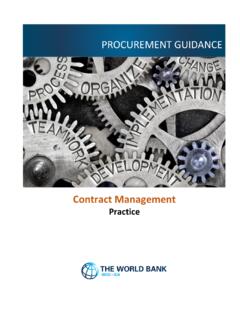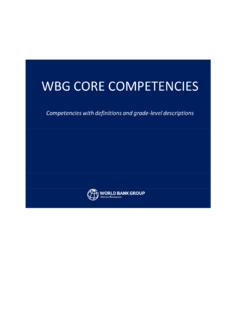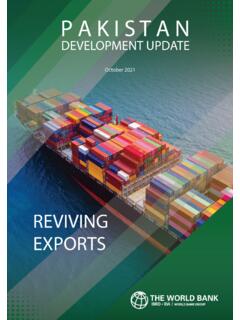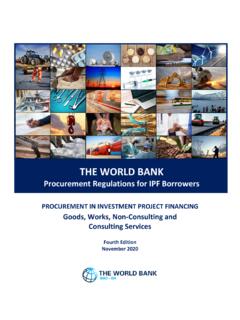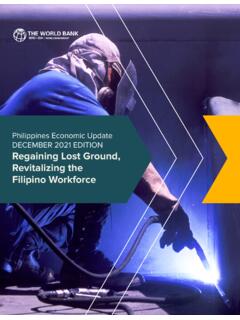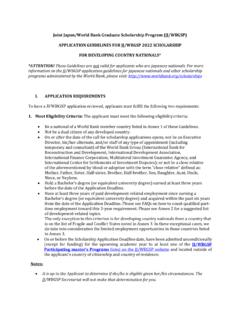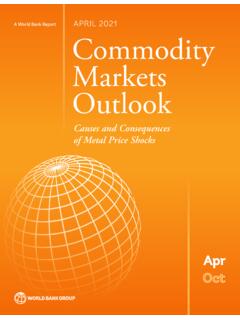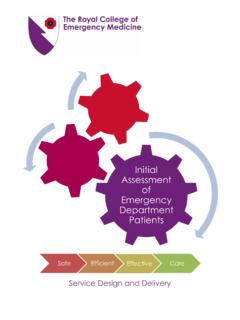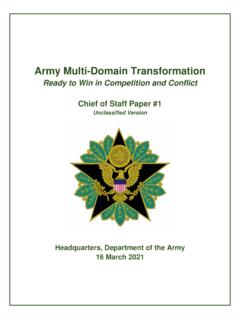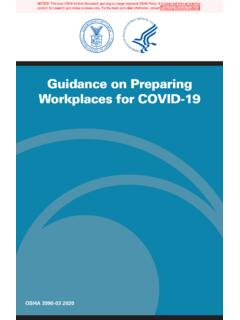Transcription of A Proposed Financial Intermediary Fund (FIF) for Pandemic …
1 A Proposed Financial Intermediary Fund (FIF) for Pandemic Prevention, Preparedness and Response Hosted by the World Bank WHITE PAPER. May 17th,2022. I. Background, Objectives and Potential Value Added 1. COVID-19 has highlighted the urgent need for collective action to augment the existing global health security financing system and mobilize additional resources for increased investments in Pandemic prevention, preparedness, and response (PPR). Avoiding future pandemics requires investing substantially more in PPR; these investments will help avert the much larger costs that the world would have to incur if we were to be caught unprepared for the next global health crisis.
2 Countries must step up domestic investments in the core capacities needed to prevent and contain future pandemics, in accordance with the International Health Regulations. This must be complemented by enhanced external financing, particularly for developing countries. The joint World Bank-WHO paper on PPR financing needs and gaps1. prpeared for the G20 Joint Finance and Health Task Force (JFHTF) estimated that external financing amounting to an additional $ billion per year, over the next five years, is needed for investments at the country, regional and global level to strengthen the capacity of low-income and middle-income countries.
3 PPR is a global public good. Mobilizing the needed external financing to strengthen PPR in low- and middle-income countries and regions, that are the most fiscally stretched and in need of Financial support, is the collective responsibility of the international community. 2. Reinforcing the multiple actors that provide international financing for PPR and enhancing coordination remain critical priorities. Multilateral Development Banks (MDBs), through their core funding mechanisms, are today the largest source of external financing for PPR in developing countries. Among MDBs, the World Bank Group has been the largest provider of PPR financing.
4 IDA20 includes ambitious commitments to strengthen PPR. Other key actors include: the WHO and other specialized UN. agencies engaged in PPR activities; multilateral agencies/pooled funds, like the Global Fund to Fight AIDS, Tuberculosis and Malaria, Gavi, and the Coalition for Epidemic Preparedness Innovations (CEPI), which are supported by FIFs for which, the Bank serves as trustee; regional actors, like Africa CDC, AVAT, and PAHO, that have stepped in to perform critical coordinating and operational functions during COVID-19, demonstrating the value and potential of platforms in which countries have a direct stake; bilateral agencies.
5 And philanthropic organizations. 3. At the same time, there is strong appreciation within the international community of the urgent need for a new multilateral financing mechanism dedicated to PPR financing. Several of the existing institutions support elements of the PPR agenda; however, the absence of a dedicated institution 1 Analysis of Pandemic Preparedness and Response (PPR) architecture, financing needs, gaps and mechanisms , Paper prepared by the WHO and World Bank for the G20 Joint Finance & Health Task Force, March 22, 2022. The paper estimated that an additional $31 billion per annum is needed over the next five years to strengthen the PPR capacity of low- and middle-income countries, about two-thirds of which will have to come from domestic financing.
6 2. for PPR means that spending on other immediate needs can take priority over equally urgent PPR. investments, particularly in inter- Pandemic years. A new multilateral financing mechanism would help to focus and sustain much-needed high-level attention on strengthening PPR during peace time, . complementing existing mechanisms. It could mobilize significant additional financing for PPR. With the appropriate structure and design, it could increase country investments in PPR, promote a more coordinated approach to PPR financing, and by convening key stakeholders, serve as a platform for discussion and advocacy around strengthening PPR.
7 (Box 1 clarifies key concepts). A new financing mechanism must however be viewed as one part of the solution to increase financing for PPR. Efforts are needed, in parallel, to enhance the governance of the wider global health security and PPR ecosystem. Box 1: Clarifying Concepts: Prevention, Preparedness and Response Disease outbreaks, epidemics, and pandemics Most disease outbreaks with Pandemic potential have a zoonotic origin, caused by a pathogen spilling over from animals into humans. An epidemic refers to an increase, often sudden, in the number of cases of a disease in a particular area. A Pandemic is defined as an epidemic occurring worldwide, or over a very wide area, crossing international boundaries and usually affecting a large number of people.
8 Prevention, preparedness, and response (PPR). Prevention encompasses the systems, policies, and procedures to determine, assess, avoid, mitigate, and reduce public health threats and risks. This definition captures interventions needed to mitigate risk and reduce the likelihood or consequences of spillover events at the human, animal, or ecosystem interfaces. Such interventions frequently reside with agriculture, food, or environmental sectors, highlighting the importance of a multisectoral, One Health approach. However, routine health systems strengthening initiatives can also be included under the definition of PPR, as prevention and preparedness are often best supported through health systems strengthening, rather than by setting up of separate structures.
9 Preparedness refers to ex ante actions that help mitigate losses when a disease outbreak occurs. It includes strengthening the capacities and capabilities at community, country, regional, and global levels to prevent, detect, contain, and respond to the spread of disease, mitigating economic and social impacts. Response refers to ex-post actions taken in response to a disease outbreak to reduce its economic, social and health impacts. 4. There is an emerging consensus within the G20 and beyond that, among the various options available, a Financial Intermediary Fund (FIF) hosted by the World Bank would be the most fit-for- purpose vehicle to fill critical PPR financing gaps.
10 The idea of establishing a FIF at the World Bank to support PPR financing was originally put forward by the G20 High Level Independent Panel (HLIP)2 and explored through a finance and health working group process under the G20 Italian Presidency. The G20 Leaders in their Rome Declaration (October 31, 2021)3 noted that financing for Pandemic prevention, preparedness and 2 A Global Deal for Our Pandemic Age , Report of the G20 High Level Independent Panel on Financing the Global Commons for Pandemic Preparedness and Response, June 2021. 3 The G20 Leaders Rome Declaration noted the following: We acknowledge that financing for Pandemic prevention, preparedness and response (PPR) has to become more adequate, more sustainable and better coordinated and requires a continuous cooperation between health and finance decision-makers, including to address potential financing gaps, mobilizing an appropriate mix of existing multilateral financing mechanisms and explore setting up new financing mechanisms.
